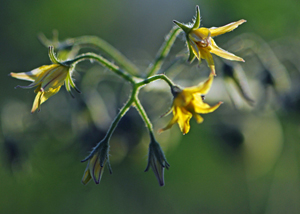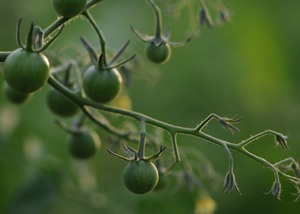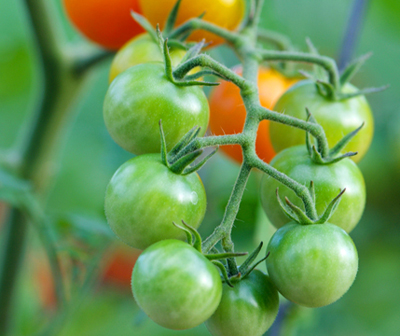Tomatoes 101
Contributed by Kerry Lake, Master Gardener
Remember last summer’s drought? Our gardens looked so tired and worn, except for the peppers and tomatoes. They loved that hot, dry weather. We canned a record number of those juicy red orbs last year. This summer seems to be just the opposite. We have had plenty of rain in April and again in May, so much so that our government officials are telling us that the drought is over. Sounds great, but what does this summer look like for our gardens. Some of our Master Gardeners have told me that they haven’t been able to get into their gardens yet because the ground is just too wet. This does not bode well for crops that like it hot and dry like tomatoes. Let’s review tomato requirements.
What do Tomatoes need?
Soil:
Rich, fertile, and well drained is what is needed, and with a pH of 6. If planting in pots, use an inner pot for the soil and seedling placed inside your decorative pot for better drainage. Go easy on using the moisture retaining potting mix; add some sand or vermiculite to your potting mix for better drainage. In the garden plant up on ‘hills of soil’ or mounds, so the tomato is above the soil level of the other plants.
Sun: the more the merrier.
Type of Tomato:
Tomatoes, as you know, are the most popular vegetable for the home gardener. They are divided into 3 main groups:
- small compact with stems 12 to 18 inches (determinate)
- slightly larger with stems growing to 18 to 30 inches (semi-determinate)
- ranging vines that continue to grow until the final frost (indeterminate)
Determinate and indeterminate, what does that mean, and should I care? Do you want the plant to continue to grow throughout the summer and produce fruit throughout the season for daily salads and side dishes? Or do you want the plant to mature to its full height and the fruit to mature all at once for making sauce and canning purposes?
If you are purchasing young plants locally (not starting from seed). Read the labels and select disease resistant varieties (verticillium wilt and fusarium).
Seed catalogs will categorize the tomato by maturity dates (early, mid-season, late), size, color and shape of fruit, and culinary use (slicing, drying, oven roasting, sauce or paste). There may also be a listing as to heirloom (open-source) or hybrid (protected patent). Again, look for disease resistant varieties.
 |
Planting:
For our zone 5 and 6, June is the time to set out our plants.
If your
seedlings are lanky and leggy, here’s an old-timer’s tip: transplant
horizontally with just a few of the upper leaves and tip above the
ground. The plant will produce roots along the buried stem.
Spacing of
the plants? Indeterminate tomatoes should be planted 24 inches apart in
rows or 30” apart if planted on trellises. These will grow taller, not
wider. Determinate can be planted 30 inches apart. Tomatoes need space
for air circulation, sun penetration, for the pollinators to easily
visit the small flowers, and for the fruit to form and mature. If
planting in pots, no matter what type of tomato, plant only one per pot.
Speaking of
Pollinators…..plant some flowers nearby to attract those insects to your
tomatoes. How about marigolds, calendula, safflower, borage, or even
chives?
|
Staking:
When planting, pound a stake (wood or metal) into the ground next to the young plants. Use soft twine to tie the up the stems. (Back in the day, I used the legs from old panty hose, remember that Girls?)
Have you tried tomato cages, ladders, or towers? If using cages, use the wider, 18 inch diameter type. These are also taller than the usual cages. For indeterminate tomato plants, you may need your support to be over 5 feet tall. There are types of supports that fold for storage in the winter, so you will be using these for years to come.
Mulching:
Mulch with straw or pine needles, to help prevent splash-up when watering from the soil to the plant leaves.
 |
Care of Tomato Plants:
Pruning
side shoots is important for all tomato types but especially for
indeterminate type which might spend all of its time growing taller and
producing side shoots. Pinch or clip off the small side shoots where
the leaf stem joins the main stem on all tomatoes. An open structure of
the plant is most desirable.
Cross
pollinating with heirlooms and other open-pollinated varieties isn’t a
bad idea either, especially if you want to save some seeds.
Watering?
Not as often as you think. Stick your finger down into the soil to
determine the moistness of your soil, or use your soil moisture meter.
It is better to water deeply once a week, than a ‘little water’ every
day. Add a little liquid seaweed fertilizer to your weekly watering.
Tomatoes like it dry, sunny, and hot; and I can’t say it enough, don’t
over-water. It is also important to water slowly at the soil level.
Water on the foliage just invites leaf diseases. To encourage fruit
formation after the flowers appear, you might work in a little phosphate
fertilizer (0-30-0) around the stem of the plant.
|
Pests
and diseases. Wash hands and tools with soap before and after doing any
work on tomatoes. Tomatoes share diseases with eggplant, nicotiana,
petunias, and potatoes. Some tomato diseases are soil borne, so plant
your tomatoes in a different section of the garden every year. For
tomatoes planted in pots, start with fresh soil every year, and make
sure the pot has been scrubbed thoroughly with soap and water, maybe
even a quick dip into a 5 gallon bucket of water with a cup of house
hold bleach. I can still hear Thalassa Cruso’s voice (PBS in the 1970s)
extolling the virtue of scrupulously clean pots.
Aphids,
whitefly, spider mites might be a problem. Pick off by hand as many of
the pests as you can. You really don’t want to use a spray of water to
dislodge the pests, because then you can bring on leaf mold. We
recommend avoiding insecticides as you will be eating the fruit of the
plant. The end of the growing season may bring potato blight.
As soon as you see a stem or
leaves turning yellow, remove and destroy. Do not put in the compost
bin; if this is blight, we do not want to have it continue into next
year
 |
Harvesting:
Harvest when the
fruits begin to feel soft to the touch. The sweet fragrance of the fruit
will also tell you when it is ready to harvest.
Sad to say, but be
advised to remove flower cluster beginning in August so that your plants
will put their energy into the ripening fruit, and not continue to
grow. This might make that advice easier to take: When the daytime
temperature is over 95 degrees Fahrenheit, the pollen fails, so August
seems to be the right time for our plants to concentrate on ripening the
fruit at hand, and not produce additional fruit.
Never, never, never refrigerate Tomatoes.
|
Resources:
The Beginner’s Guide to growing Heirloom Vegetables by Marie Iannotti, published by Timber Press. Her recommendation for first time tomato gardeners is the Brandywine heirloom tomato.
Also by Marie Iannotti is Vegetable Gardening in the Northeast, and again published by Timber Press.
Growing Beautiful Food, written and photographed by Matthew Benson, published by Rodale.
Geoff Hamilton Organic Gardening published by DK publishing.
The Vegetable Gardener’s Guide to Permaculture by Christopher Shein with Julie Thompson, published by Timber Press.
Vegetables and Fruits by James Underwood Crockett, and published by Time-Life Books.
All About Vegetables, Midwest Northeast edition, edited by Walter L. Doty.
Gardening 101, The Best of Martha Stewart, published by Martha Stewart Living Omnimedia.